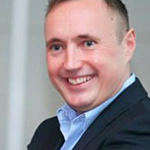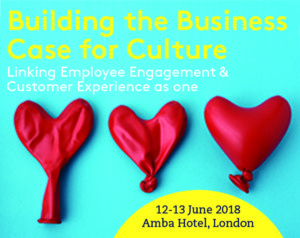Building a Business Case for Culture
What business transformation leaders can learn from painters and decorators.
Life and business are always running in parallel and, if recognised, the learning in one world can define the level of success in the other. Following the premise that businesses behave like humans simply because they are driven by humans, I am always on the hunt for new and compelling examples. I had this put to the test with my most recent project of painting my entire flat in less than one week.
I thought this was the perfect opportunity to immerse myself in a different kind of transformation and to look at what learning I would discover over this week. It became apparent early on that these two worlds would be clearly linked and life had thrown me yet another opportunity to better define company culture transformation through a unique lens. It has also given me a heightened respect for individuals that master such tasks as a profession.
To help better put this article into context, I believe that it requires a small amount of personal narrative. I decided last year that I needed a change and put a fresh perspective on life and, as part of my quest for personal transformation, I uprooted and rented out my flat of 12 years. I have become a firm believer that change is required to keep us fresh-minded and a little shake-up is needed to challenge and energise that habitual soul that sits inside us all.
As the tenancy lease came to an end and it was time for me to move back into my property, I was faced with a mix of excitement and trepidation. As with any form of change or transformation, the thought of the unknown and the ‘what might be’ can weigh heavy on our minds and perception of how we view what comes next. In the case of my flat, I needed to put in place the next right move in order that I would re-enter this stage with a fresh and forward-thinking mindset.
Hence, the answer to this was giving it a transformation of its own and as project lead, labour and owner I was prepared to take on the challenge myself. To follow is 10 key learnings that I discovered during my week that directly relate to any leader that is building a business case for culture and seeking internal investment. Once you embark on any people or business transformation programme it is imperative that you are in it for the long haul.
One: Best Laid Plans
As with any transformation project, preparation is key and ensuring that you have all the tools in place to hit the ground running on Day One. This will take the form of communication, people and assets that will be utilised throughout your campaign. I am a firm believer in having a launch day and celebrating the changes that are coming and to be open and transparent in the vision of the organisation going forward; however, one needs to be agile at the start of any transformation initiative, as even with the best-laid plans things do not always go quite as expected.
In the case of my decorating week, this was very evident in the fact that I had made my list of all the painting accessories that would be required – from brushes to drop sheets. Being a fan of Amazon Prime, I ordered all I needed and more to be delivered the day before the start date. Of course, this was cutting it fine however Amazon had never let me down before so was not expecting any issues now. I take full responsibility for the outcome as the card I used on file had expired and hence meant the Friday delivery would not come. This is the point that your stress levels will be put to the test so just relax and calmly think what is the next right move.
As leaders, we can get stuck here in the continuous circular mindset of what should have happened and therefore struggle to remain positive and focused on the future pathway. So the painting stuff did not arrive and if that was going to be my directive then I would never get past this first hurdle and get moving. In my case, I had to go old school and actually go to the paint store on the high street and physically pick it up. In doing this, it also reminded me of the value that we get from coming face-to-face with experts in their field and, therefore, it was actually a blessing in disguise as I got some firsthand great advice and cost savings to boot.
Two: Plan for the Unexpected
Following on from best-laid plans, it is important to continue this agile way of thinking going forward and remember we are people dealing with people. Hence, there will always be a degree of volatility in these relationships and at the beginning of any transformation project be prepared to have a difference of opinion. In the case of my flat, this came at the checkout of the existing tenants in which their view and my view of what was required differed greatly.
It was agreed that the flat would be cleaned and ready for sign off; however, this was not what I discovered. The flat was not cleaned to the expected standard and was not fully cleared and ready for me to start work. As leaders, we often need to deal with the unexpected as even with the best planning we must build in contingency for the things that are outside of our control and learn to deal in real time. Often, we believe that we have been clear in outlining our expectations only to be met with a very different interpretation by others of what was communicated.
Three: Painting Party
To help lighten the load I had the Idea to dedicate the first weekend to have a painting party. In theory, this would have brought several friends together enticed by pizza, beer and the community spirit to pick up a brush and get to work. As I said, “in theory” as it did not really happen according to my desired vision as I never communicated this concept until the very last minute. As of which time, diaries were full and other commitments made and what would have accelerated the transformation process was lost due to my poor communication.
This brings rise to the importance of clear and timely internal dialogue leaders must have with their team. In most client projects that I have worked on over the past 20 years, poor internal communication by senior leaders is sighted as one of the key contributors to front-line disengagement. It is key that we communicate our vision through all potential mediums available and not just email. Leaders need to be visibly present and active throughout the entire culture transformation programme. They need to be in constant communication with all the team, not just the other stakeholders that share a seat at the table.
Four: Bigger Job than Expected
As the weekend passed and I was moving into Day Three and Four of the flat transformation, I came to the realisation that the job was much larger and more time-consuming than I ever expected. What I estimated would take 30 minutes took 3 hours and on and on and on. This really enlightened me to just how unrealistic I could be with respect to time and the input required to reach most desired outcomes. Hence, in this, the project was falling behind schedule simply because I did not set the appropriate timeline from the onset or apply the appropriate people power to the work.
As a leader, when embarking on any transformation programme, be assured that it will require your full attention and if done well will take much more time than originally expected. So often I have seen leaders take on additional responsibilities that really could be delegated to others simply because they either do not trust their team or they misjudge the amount of additional work that goes into the various task required. It is key to build a great and supportive community around you and allow others to fail in order that they can be empowered to learn. Trust in others and communicate the vision in a way that they will assist in spreading the responsibility for many people.
Five: Balance between Roles
Having misjudged the amount of dedicated time that was needed to complete the entire flat, this then began to impact my responsibilities at Bridge. It suddenly became the domino effect and a clear balancing act between the two commitments was needed. Thankfully, I had the support required that meant I could just step away from most of my daily work commitments and focus on the painting task at hand. Without this, I would have been pushed and pulled between the two and only been half present in each.
If this becomes the case then both worlds will be impacted with a degree of mediocrity and momentum is lost. In respect to any form of business transformation, I call this “programme fatigue” and it is the point that key stakeholders and leaders begin to lose the drive and focus on the transformation programme. The day job comes first and, also, it becomes a great hiding ground from those leaders that are a little unsure what is really expected of them with regards to the people and culture piece. It is important to recognise this stage as normal and one that needs to be utilised to check on progress, refocus and re-engage everyone back into the vision.
Six: Wellness and Resilience
This would not be a review of business transformation without a consideration for the importance of wellness in both ourselves and for others. It was not until after the flat had been completed that I began to look back at the week through this lens and realised just how low a consideration I gave this during the process. I was so focused on completing the task that I stopped to look at the impact that working in this way had on my health and wellbeing. I mistook my bullish nature for resilience and gave no consideration to the impact that this had on my health.
Clearly, working this way for one week had no long-term effects and after a few down days I was back fit and fighting; however, it does shed light on the importance of managing a good work-life balance and the need that we have to step away in order to step up to the many commitments that leaders face in today’s demanding work environment. Resilience is not about just toughening up and getting on with it, as it is much more complex than that. It is about having the emotional and social intelligence to create an environment that brings out the best in you, your team and one that allows all the ability to deliver at their best.
Seven: Budget and Investment
The balancing act between cost and quality will always be on the agenda with every transformation programme and, hence, with respect to my flat, this was no exception. It is important to create a clear budget for all projects and cost must be a factor when determining the purchase of any goods or services. It is important to know where to save money and where to invest, as in many cases cheaper does not always equate to a cost-saving in the long run. For anyone that has ever painted with a cheap paintbrush, they will know the difference in the number of bristles that it sheds when using it.
Often organisations attempt to cut cost on staff engagement and development during a transformation initiative. It is believed by many stakeholders that this is the soft agenda and can be simply managed by the in-house leadership team. In no way is engagement simple – and investment in third-party assistance is often required as people are the greatest asset of any business. Human behaviour and engagement is a science and sits outside most leaders’ remit and true skillset. To ensure long-term sustainable engagement of a workforce that delivers on the brand promise and offers an outstanding customer experience should never be taken lightly. Just because the brush put paint on the wall did not mean the brush would deliver the best result or last to complete the entire job.
Eight: Attention to Detail
I believe that ATD is one of the areas in which true professionals excel, as not only does it require a keen eye and passion for the task but is developed from a vast amount of experience. As my week of painting and decorating unfolded, I seemed to go on a ride of ups and downs on how I felt and delivered on this crucial quality factor. Having worked on the transformation of a 5-star branded hotel to that of a 5-star boutique property, I determined that one of the key differentiators in the 5-star hotel market is the attention to detail that is applied. It was this level of quality that I wanted to see in the finished flat and hence was faced with an even greater challenge.
At the start of the painting project, I was still learning how best to ensure that the quality was delivered in enough detail to guarantee that it was completed to a high standard but once my resilience dropped and fatigue set in, I began to notice that this was the first thing to be impacted. I simply just wanted to get the job done! Once I started to see the transformation take shape in the final days, my desire to ensure that the proper detail was taken returned and ATD became much more important. It is crucial that leaders track the engagement of their people against this crucial factor, as this will give sight to the sustainability of the care and standard of work to be done in the future.
Nine: Take Time to Appreciate
Celebrating success is a must to ensure that engagement and hard work is recognised and seen as a true accomplishment. I was so pleased to have finished the journey that I almost forgot to sit back and appreciate the transformation that had taken place. Not only in the look and feel of the flat but also in myself. I took on the challenge and even though it was much harder than I ever expected – I did it. I had the support of some great friends who joined me on my journey and this definitely contributed to the successful outcome.
However, it is important to recognise the journey in real time and not wait until the end to see the success. Every day of a transformation programme brings with it both challenges and exciting success. The role of leadership and internal communication is to find active mediums to share the stories of their employees. The difference that I see between change and transformation is that the first is needed to take a totally new direction whereas the latter is about laying new and exciting opportunities on an already stable core. It is within this essence that we find the true passion of our people and take notice of the hard work and commitment that they deliver daily.
Ten: Continuous Improvement
It will not stop with paint as this project has now inspired me to make some additional improvements to both the flat and also in the way I view transformation. It is not something that can be seen as just a tick-in-the-box exercise and one that, once completed, means that it can just sit untouched or it will slowly fade back into the existence that it once was. This project was more challenging as it was left untouched for a few years and hence needed lots of attention. It has also given rise to additional areas that with a little work can truly make all the difference to the overall transformation. It is important to ensure that once the journey of transformation has begun it is seen as a continuous commitment.
Once the main planned strategy has been completed, I often advise clients that they then need to ring-fence areas of their business that will require very specific influences to perfect the performance of that area. The first stage of any transformation is to ensure that the culture is engaged and committed to the long-term vision and strategy of the business. Once this fresh new outlook has been assured then the team is open to the concepts and development to truly make a difference in the success. Then this is their opportunity to take ownership of the part they play; however, it is important to recognise that people and great customer experience need constant attention and the commitment of senior leadership. It is not a fad or a phase – it is a long-term continuous journey that, once started, should never end.
In conclusion: this weeklong experience has given me a new respect for professional painters and decorators. Before I started this project I went to the market and got three quotes all of which I thought were too high and hence I made the choice to do it myself. On reflection, it was my lack of true knowledge of what went into the entirety of such a project from end to end and the skills that they offered that I truly lacked. All three quotes were well within reason.
What may look easy on the surface comes from both a wealth of inherent skill and learning experience which, when brought together, can make all the difference to both the journey and the final outcome. My advice to any leader that is looking to embark on culture or business transformation initiatives is to invest in the advice of either internal or external individuals that have experience in such a project. Also build a great team of people around you, as their support will be invaluable as the programme rolls out across the business.






























